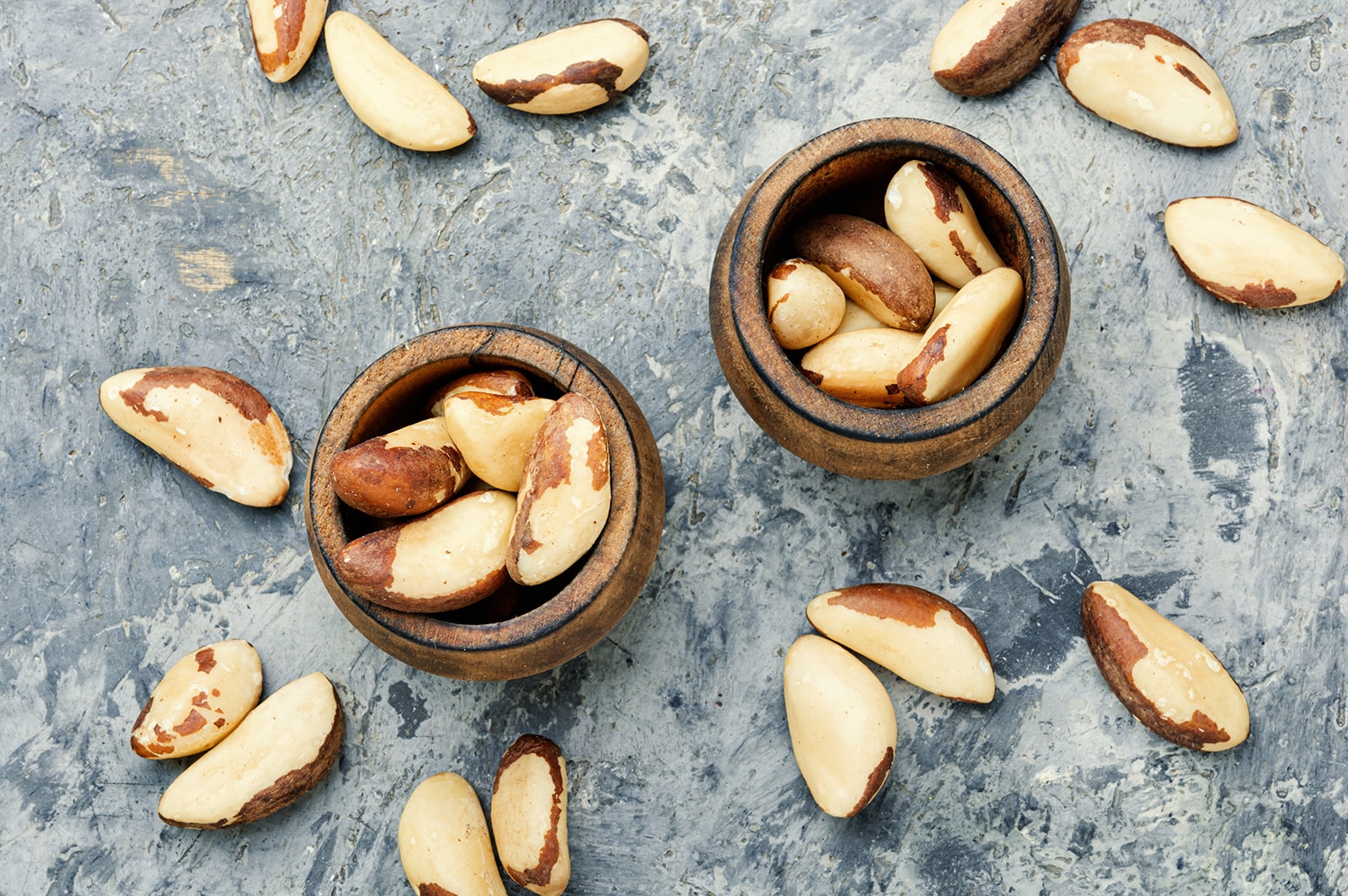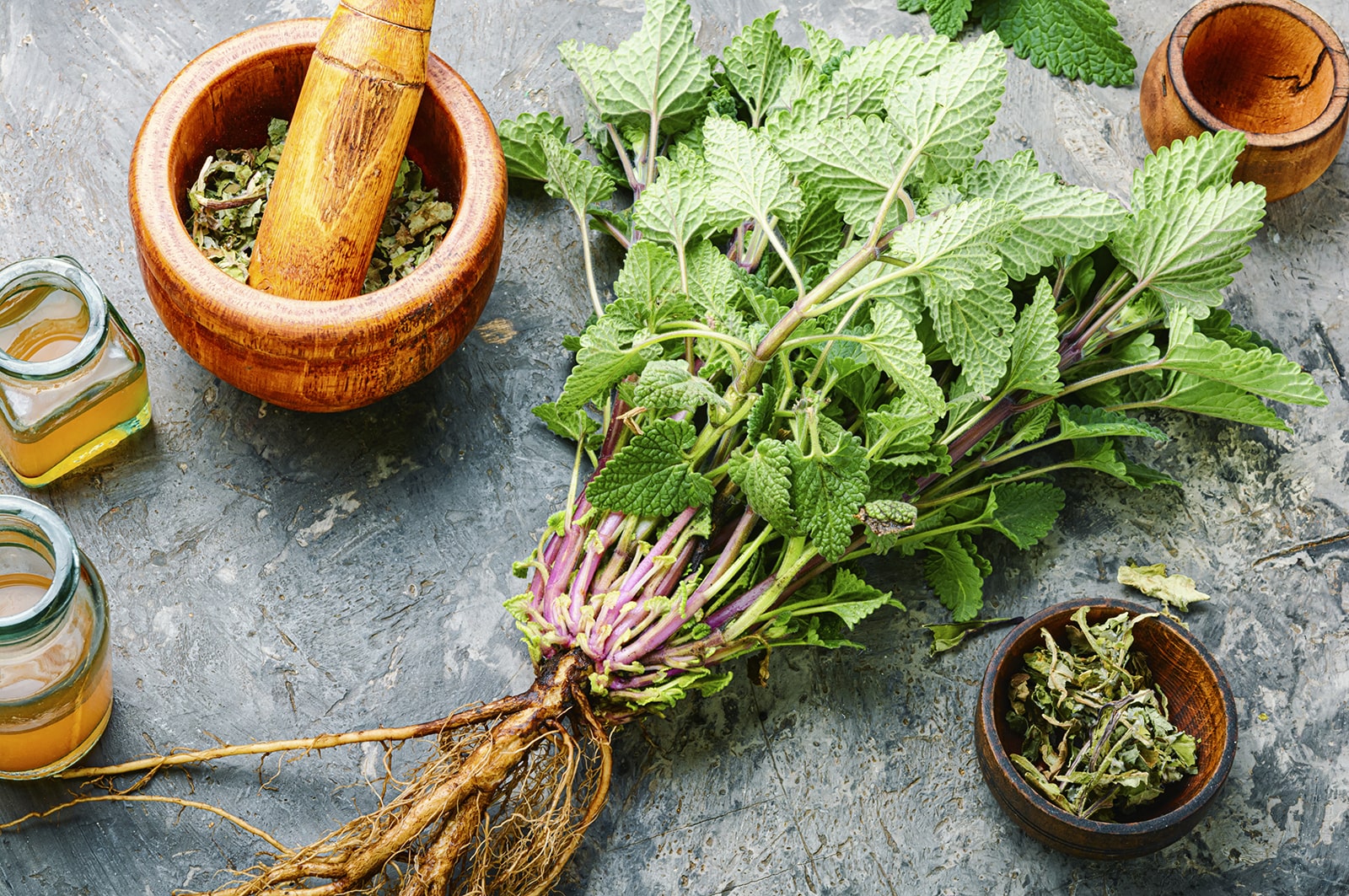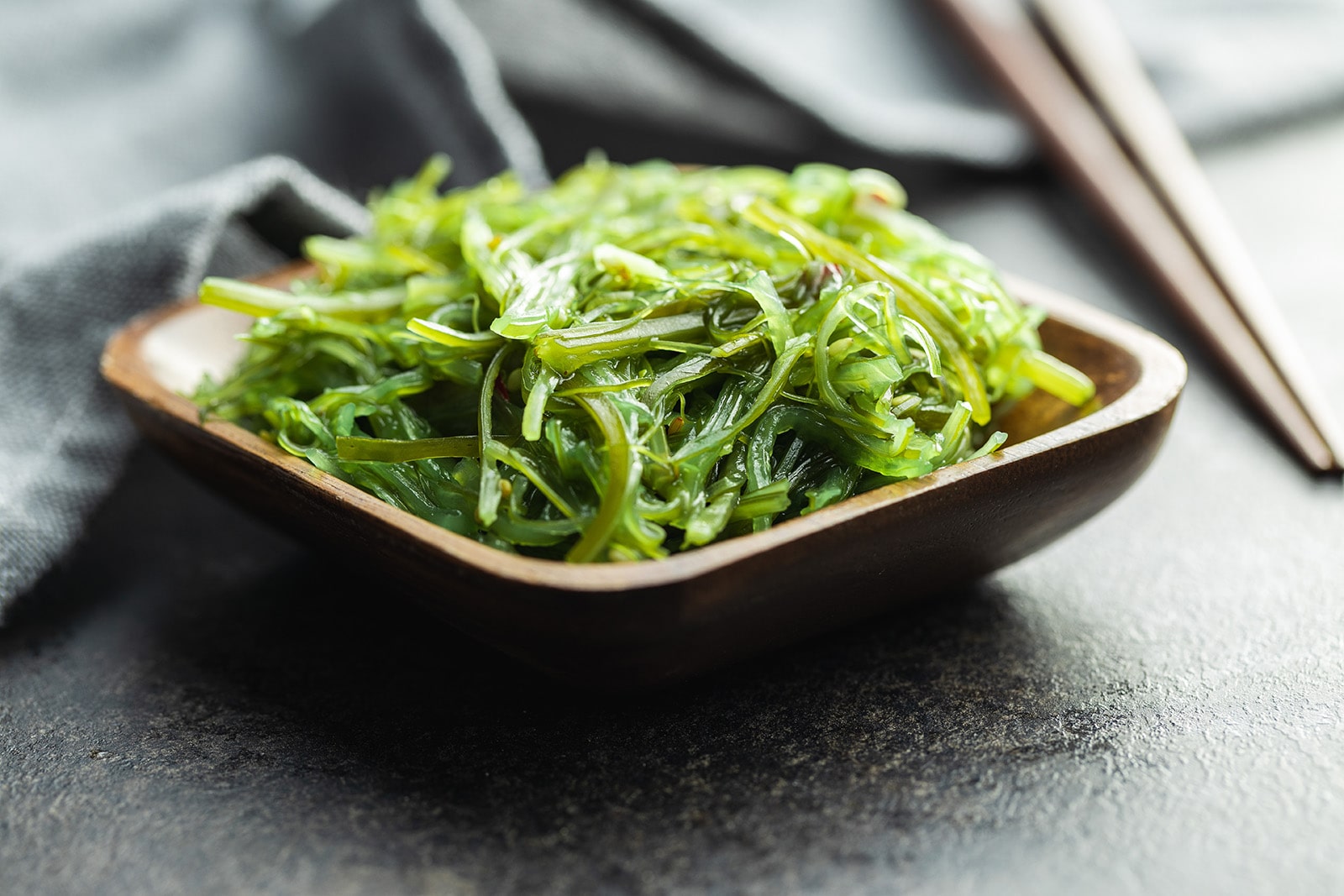Brazil Nut Butter Recipe
Brazil Nuts
Brazil nuts are calorie and nutrient dense. High in mono- and polyunsaturated fats, including omega-6 fatty acids, a one-ounce (6-7 nuts) serving provides about 185 calories, 5 grams of protein, and a rich supply of magnesium, phosphorous, potassium, and selenium. In fact, Brazil nuts are the highest natural source of selenium (543 mcg in 1 oz.).
A potent micronutrient, scientific evidence to date suggests that selenium might play a role in the prevention or treatment of heart disease, cognitive decline, liver disease, some types of cancer, and thyroid disease. Selenium concentrations are highest in the thyroid gland, and it has a vital role in its function.
Just two Brazil nuts a day make it easy for most people to meet their daily selenium requirement. But it’s important to work with a clinical nutritionist to assess your individual need for selenium if you suspect a deficiency to ensure you’re getting the right amount.
Because it is possible to get too much selenium, The Institute of Medicine of the National Academy of Sciences advises a maximum limit of 45 mcg of selenium for kids and 400 mcg for adults daily. The best way to enjoy Brazil nuts is to combine a few with other types of nuts, seeds, and raisins. Sprinkle on salad, yogurt, or blend into a smoothie.
Brazil Nut Butter Recipe
Homemade nut butters is a great opportunity to enjoy these nutritious spreads without added sugar, salt, or preservatives often found in store-bought varieties.
Note: There is a 2 to 1 ratio of nuts to nut butter. To make 1 cup of nut butter, start with 2 cups of shelled nuts.
Ingredients:
- 2 cups organic raw nuts (feel free to mix it up, equal parts brazil, almond and cashew for example)
- Optional flavor add-ins (all to taste; opt for organic or locally sourced):
- Salt
- Stevia, local, raw honey, or grade A/B maple syrup
- Vanilla or almond extract
- Cocoa powder or cacao nibs*
- Puree of dried fruit or dried fruit bits* (apricot, raisin, cherry, cranberry)
*The former creates a smooth spread, the latter chunky.
Prep:
To make the nuts more digestible, soak and dehydrate the nuts to extract phytic acids (compounds that bind minerals). Before grinding, soak nuts in water and cover for 8-12 hours. Dehydrate about 10 hours.
(optional) To add a distinctive, warm flavor, toast the nuts before grinding. Toast nuts on a dry baking sheet at 400°F until nuts are fragrant and lightly browned, 5 to 10 minutes. Watch closely; nuts easily scorch. Nuts should be cool to the touch before grinding.
Equipment:
Food processor or high-speed blender (e.g., Vitamix).
Directions:
Place nuts into a food processor and start blending, leaving out the optional flavor add-ins. Blend for 11-12 minutes. You may need to grind at various speeds or intervals until you reach the consistency that meets your taste preferences. The nuts will go through several stages and you’ll need to keep pressing the contents into the center of the blender as you go through the process: The nuts will crumble, clump, ball, redistribute, and then finally … the oils will release, and you’ll have a nice spread.
Mix in your choice of flavor add-ins by hand. Nut butter keeps in the refrigerator for about a month.
Resources
- National Institutes of Health. “Selenium: Dietary Supplement Fact Sheet.” Accessed May 2015.
- National Institutes of Health. “Selenium: Fact Sheet for Consumers.” Accessed May 2015.
- Nutrition and You. “Brazil Nuts Nutrition Facts.” Accessed May 2015.
- Anton Health and Nutrition. “Homemade Nut Butter.“
- Radiant Life Company. “That’s Nuts! A Complete Guide to Soaking Nuts and Seeds.”
Healthy Hair, Skin, and Nails
Healthy Hair, Skin, and Nails: A Nutritional Approach
The condition of your hair, skin, and nails (AKA the integumentary system) are a reflection of your overall state of health. For example, they can be a diagnostic symptom when diagnosing thyroid deficiency since they share similar nutritional requirements. Aside from the aesthetic appeal, having thicker hair, stronger nails and bright, clear skin may actually be a sign that vitamin levels are sufficient for optimal biological function.
A variety of factors can affect their condition, including genetics, exposure to tobacco smoke, sun damage, medication and drug use, and of course, nutritional deficiencies. While eating a well-balanced diet is the best way to keep the integumentary system healthy, sometimes vitamins can be a helpful insurance policy. Vitamin supplementation can replenish depleted vitamin stores and support the biological processes that boost growth of hair, skin and nails while simultaneously helping to tame the symptoms of hypothyroidism.
Honestly, vitamin formulas for healthy hair, skin, and nails contain many of the same nutrients that your entire body needs for growth and maintenance of cells. That’s because if your body is deficient in key nutrients needed for biological function, it is reflected in poor the integumentary system health (weak nails, brittle hair, and dull skin, for example). When addressing Hair, skin, and nails specifically, we’re look at vitamins that support keratin production- a protein essential as a building block for the integumentary system- as well as supporting repair and regeneration of new cells.
Biotin & the mighty B vitamins
The B-complex (B12, B3, and B6) are vital for dozens of biological reactions, including for hair and skin growth. Biotin, also a B vitamin, is sometimes used to help reduce or prevent hair loss. Some people do not get enough biotin in their diet, resulting in a systemic deficiency. In such cases, research has shown taking biotin supplements may help alleviate hair thinning. Biotin-rich foods include peanut butter, eggs, avocados, legumes, and bananas.
Vitamin D
Vitamin D is important for hair follicle cycling. A large portion of the population reports low supoptimal vitamin D due to reduced sun exposure, use of sun block, reduced intake of certain Vit D rich foods, and geographical location (i.e. individuals who live in northern parts of the United States where sunlight is limited). Click here to read my blog on supplements, including vitamin D. Salmon, mushrooms, beef liver, and grains are great food sources of vitamin D.
Zinc
Zinc is a key trace mineral for hair growth, wound healing, healthy skin, and immune function. People who are under high stress, fighting chronic infection, elevated toxic load, sluggish thyroid or adrenal fatigue are at greater risk for zinc deficiency. Zinc-rich foods include red meat, oysters, lamb, turkey, pumpkin seeds, and chocolate.
Vitamins C
Vitamins C is a powerful water soluble antioxidant, helping reduce DNA and cellular damage and increase cell turnover (boosting growth!). It’s also a necessary component in collagen formation helping improve skin elasticity for more youthful appearance. Vitamin C rich foods include citrus fruits, strawberries, mango, broccoli, kale and bell peppers.
Vitamin E
Vitamins E is a powerful fat soluble antioxidant. Research has shown that it plays a major role in protecting cells from damage and supporting cellular regeneration- both of the integumentary system as well as for cardiovascular health. Good sources are seeds, dark green veggies, safflower oil, and citrus fruits.
Essential Fatty Acids
Omega-3 and omega-6 fats have been shown to reduce inflammation and support skin and scalp health. You can obtain essential fatty acids from eating cold-water fish such as mackerel, salmon, sardines, anchovies, tuna, pollock, or shrimp. However, these fish can contain high levels of heavy metals—which in turn can deplete your zinc stores (among other physiological stressors). Follow these guidelines for safer consumption. If you are averse to eating fish, or are vegan, flaxseed oil or algae oil are great alternatives.
Horsetail (Equisetum telmateia)
Horsetail is an herb with antibacterial properties as well as remineralizing effect. It is rich in flavonoids, potassium, and silicon, which are vital to the functioning of rapidly growing tissues such as skin and nails. It also has a key role in the synthesis of collagen.
Resources
- National Institutes of Health. Vitamin and Minerals Supplement Fact Sheets. Accessed May 2015.
- Szyszkowska, B., et al. “The Influence of Selected Ingredients of Dietary Supplements on Skin Condition.” Postȩpy Dermatologii i Alergologii 31, no. 3 (June 2014): 174–181.
Lemon Balm (Melissa Officinalis)
Lemon Balm (Melissa Officinalis)
Native to Europe, lemon balm is grown all over the world. It is found in backyard herb gardens, in crops grown for medicine and cosmetics, and is used to scent candles and furniture polish. In the spring and summer, the flowers grow where the leaves meet the stem. If you rub your fingers on these leaves, your fingers will smell tart and sweet, like lemons. The leaves are similar in shape to mint leaves, and come from the same plant family.
As far back as the Middle Ages, lemon balm was used to soothe tension, to dress wounds, and to treat ailments such as toothaches, skin irritations, and sickness during pregnancy. As a medicinal plant, lemon balm is considered a calming herb that has traditionally been used to soothe menstrual cramps, reduce stress and anxiety, promote restful sleep, and ease gastrointestinal complaints (e.g., indigestion, gas, bloating, and colic). It is often combined with other herbs in teas or tinctures for relaxation, such as valerian and chamomile. Having trouble sleeping? Most research on lemon balm has shown that, when added to some sleep hygiene modifications, can be very beneficial for reducing insomnia.
In Europe, lemon balm has been used for treating thyroid problems and has shown an ability to regulate thyroid hormone production. It has been used in the U.S. as a complementary treatment for Graves’ disease, an autoimmune condition in which the thyroid gland is overactive.
Lemon balm may be formulated as a tea, tincture, or cream/ointment. Herbs do interact with other medicines and should not be taken without consulting your wellness practitioner for appropriate dosing.
Resources
- Restorative Medicine. Database Search: Lemon Balm and Thyroid Disease.
- University of Maryland Medical Center. “Hyperthyroidism.” Reviewed April 4, 2012.
- General Herb Information, The Herb Society of America. “Guide to Lemon Balm.”
- University of Maryland Medical Center. “Lemon Balm.”
Optimizing Thyroid Function
Optimizing Thyroid Function
It might be tiny, but thyroid gland is powerful! According to the American Thyroid Association, an estimated 20 million Americans have some form of thyroid disease. What’s even more staggering, is that up to 60% of those with a thyroid condition are unaware of it!
Located just below your Adam’s apple, in the middle of the lower neck, is a butterfly shaped gland responsible for the regulation of your inner state of balance (also referred to as homeostasis). There are generally three categories of malfunction: Hyperthyroidism, hypothyroidism, and autoimmune disease. The effects of malfunctioning (either over or under active) thyroid can manifest in various ways:
- Sluggishness, fatigue and difficulty getting things done
- Weight gain
- Difficulty concentrating
- Elevated LDL (that’s the bad cholesterol)
- Irritability, anxiety, and/or rapid heart beat
Let’s take a minute to find out more about what the thyroid does, how to know if there’s a problem, and most importantly optimizing thyroid function.
Thyroid Function Overview
The thyroid is part of the endocrine system, which includes the pituitary gland, hypothalamus, thymus, pineal gland, testes, ovaries, adrenal glands, parathyroid, and pancreas. It makes hormones, primarily T3 and T4 but has effects on production of other hormones as well. Hormones travel through your bloodstream and regulate your metabolism, brain and heart function, and reproductive and menstrual cycles.
When the thyroid is not functioning properly, a chain reaction of hormonal events takes place that involves many other glands/hormones of the endocrine system and the bodily systems they regulate. The end result is one of two primary types of health conditions: hyperthyroidism or hypothyroidism. (Autoimmune disease often results in either hypo- or hyper- function)
Hyperthyroidism results when the thyroid is overactive. Think of hyperthyroidism like a butterfly that can’t stop fluttering its wings. Everything is on overdrive, including metabolism, frequency of bowels, emotions (anxiousness), increased sweating, and for women, very light menstruation or cessation of the menstrual cycle. Symptoms often include feeling hot and difficulty maintaining a healthy weight. There are also bouts of exhaustion from trying to maintain this intense state of arousal and it often puts the adrenal glands on overdrive.
Hypothyroidism results when the thyroid is underactive. This is more common condition of the two. In this case, the butterfly just can’t get its wings to get going. Weight gained, sluggishness, and brittle hair and nails are very common symptoms. These are also often accompanied by feeling cold and tired, depressed, and often suffering from constipation. Menstruation for women with hypothyroidism is often irregular and heavy.
5 Ways for Optimizing Thyroid Function Naturally
- Eat from the sea. The sea provides many natural sources of iodine, a building block of the thyroid hormone. Table salt has a high concentration of iodine because it’s been fortified, but it can also raise blood pressure. Sea salt is also a good source of natural iodine, but should also be used sparingly if you are having water retention issues or concerned about hypertension. Instead, you may choose to opt for saltwater fish, or seaweed. Cod and halibut are high in selenium, which protects the thyroid gland during periods of stress and helps regulate hormone synthesis. Fish oil provides essential fatty acids that reduce inflammation, which plays a role in causing autoimmune diseases.
- Eat from the earth. Eat foods high in B vitamins, which are precursors to thyroid hormones and influence cell energy. Balance your diet with poultry, nuts and seeds, legumes, and whole grains (avoid refined grains* like bread and cereals). Red meat provides iron, zinc, magnesium, and other minerals essential for thyroid hormone function, and the health of other bodily systems affected by thyroid disorders (skin, hair, metabolism).
- Relax. A daily relaxation practice, such as just 10 minutes a day of silence, deep breathing, or meditation can make a big difference in the state of mind and as a result, the body.
- Move! Exercise at least 30 minutes a day. Yoga is particularly good for thyroid health, including poses such as butterfly, fish pose, shoulder stand, and child’s pose. Not the yoga type? No problem! Any exercise, as long as you’re consistent, can be beneficial.
- Get supplement-al insurance. Our diets aren’t always perfect, so supplementing with a vitamin/mineral or botanical (herb) regimen can provide extra insurance against exposure to stress, toxins, and perhaps your own family history. Confused about what nutraceutical product is best for you? Talk to a nutritionist or someone qualified to evaluate your need and give appropriate recommendations. (email me to find out about the Supplement Overhaul).
*A note on refined grains: Flour is often fortified with bromine, an element that resembles iodine. Unfortunately, when ingested bromine often replaces iodine in the thyroid, causing the thyroid to under-perform. You can find “unbrominated flour” products, but in general this is yet another good reason to avoid refined carbohydrates, and stick to whole grains.
If you suspect a thyroid condition, talk with your wellness provider right away. There are a variety of tests that can help your doctor and clinical nutritionist create an appropriate and integrative treatment plan for optimizing thyroid function and re-balancing your hormones.
Resources:
- American Thyroid Association. “General Information/Press Room.” Retrieved July 1, 2015, from http://www.thyroid.org/media-main/about-hypothyroidism/
- American Association of Naturopathic Physicians. “Natural Therapies for Hypothyroidism.” October 11, 2013. http://www.naturopathic.org/blog_home.asp?Display=1452
- American Thyroid Association. ATA Patient Education Web Brochures. Accessed May 2015. http://www.thyroid.org/patient-thyroid-information/ata-patient-education-web-brochures/
- Hormone Health Network. “Your Thyroid: What You Need to Know.” Accessed May 2015. http://www.hormone.org/~/media/Hormone/Files/Infographics/Thyroid%20low%20res%20EN.pdf
- Women to Women. “Alternative Hypothyroidism Treatment.” Accessed May 2015. https://www.womentowomen.com/thyroid-health/alternative-hypothyroidism-treatment-2/




